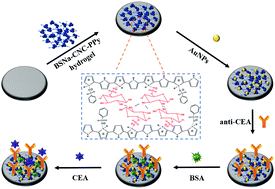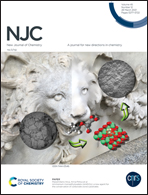Cellulose nanocrystalline and sodium benzenesulfonate-doped polypyrrole nano-hydrogel/Au composites for ultrasensitive detection of carcinoembryonic antigen†
Abstract
Precise and early detection of carcinoembryonic antigen (CEA) as a tumor marker of various cancers provides the best hope for the treatment of the deadly malignancy. Thus, the design of an immunosensor with high sensitivity is significant for early and accurate detection of CEA. In this work, a novel label-free electrochemical immunosensor was designed for the detection of CEA based on a nanostructured conductive polymer hydrogel loaded with gold nanoparticles (AuNPs). The hydrogel (BSNa-CNC-PPy) was simply prepared via in situ synthesis of polypyrrole (PPy) using cellulose nanocrystalline (CNC) and sodium benzenesulfonate (BSNa) as dopants to participate in the formation of the three-dimensional nano-hydrogel. AuNPs were further electrodeposited on the surface of BSNa-CNC-PPy gel-modified glassy carbon electrode (GCE). The immunoassay platform was obtained when the AuNPs/BSNa-CNC-PPy gel/GCE was incubated with anti-CEA and blocked by bovine serum albumin in succession. By combining the advantages of biocompatibility, nanostructure, outstanding hydrophilicity, excellent film-forming ability as well as the gelatinization of CNC, the CNC-PPy gel/GCE showed high conductivity (electroactive surface area), strong hydrophilicity, and film-forming property. The introduction of BSNa improved the conductivity of BSNa-CNC-PPy gel/GCE further due to enhanced interchain charge transport of PPy chains. The BSNa-CNC-PPy gel/GCE showed a 214% increase in electroactive surface area and the dried BSNa-CNC-PPy gel demonstrated a large specific surface area (76.59 m2 g−1), which were superior to those of existing conducting polymer hydrogels. AuNPs were apt to immobilize a mass of antibodies and accelerate electron transfer. The fabricated CEA-detecting immunosensor displayed a wide linear detection range of 1 fg mL−1 to 200 ng mL−1 and an ultralow limit of detection of 0.06 fg mL−1 (at a signal to noise ratio of 3). In addition to high sensitivity, the immunosensor exhibited excellent stability, high selectivity, good reproducibility, and strong reliability for real sample analysis. The proposed label-free electrochemical immunosensor has potential to be a diagnostic tool in clinical analysis of CEA.



 Please wait while we load your content...
Please wait while we load your content...